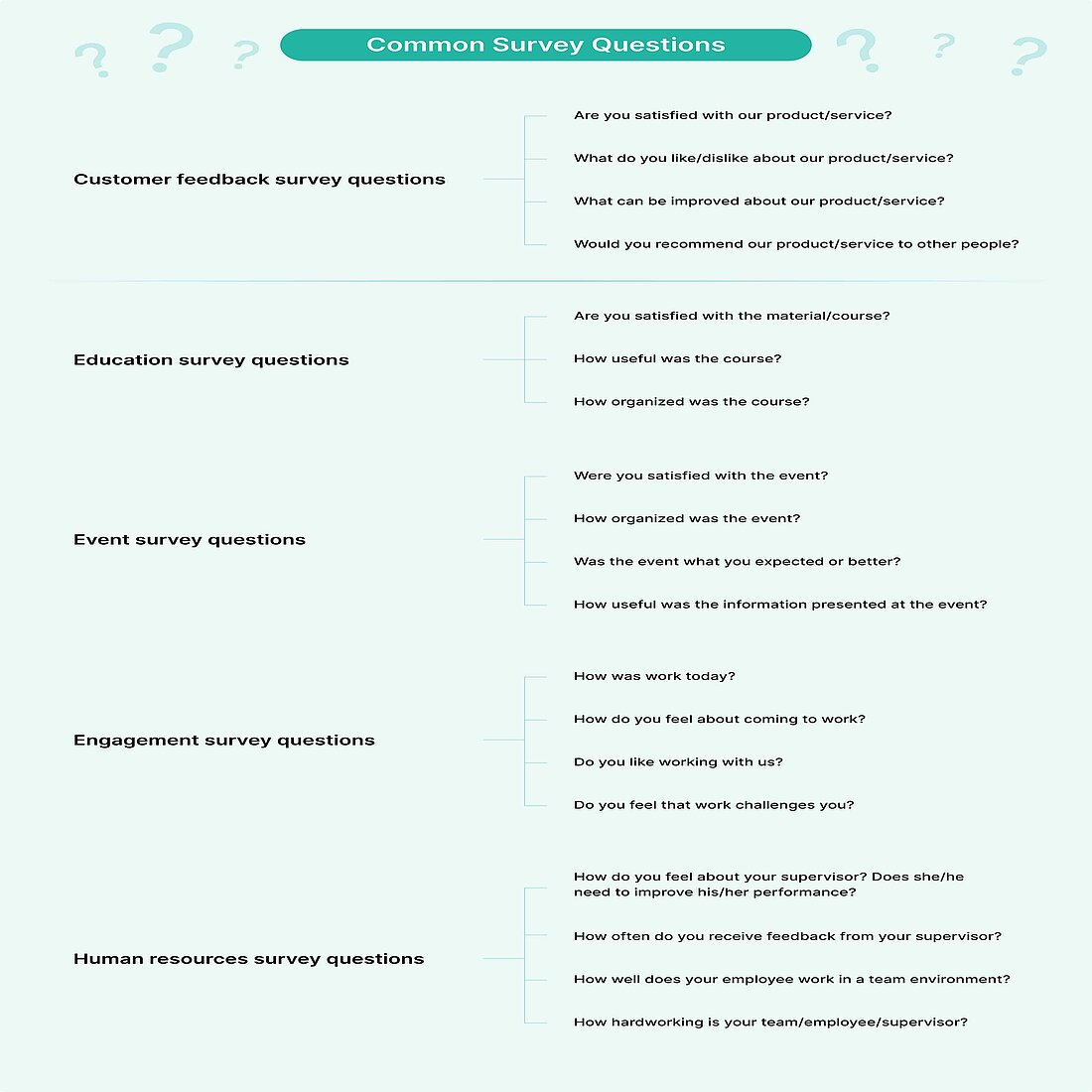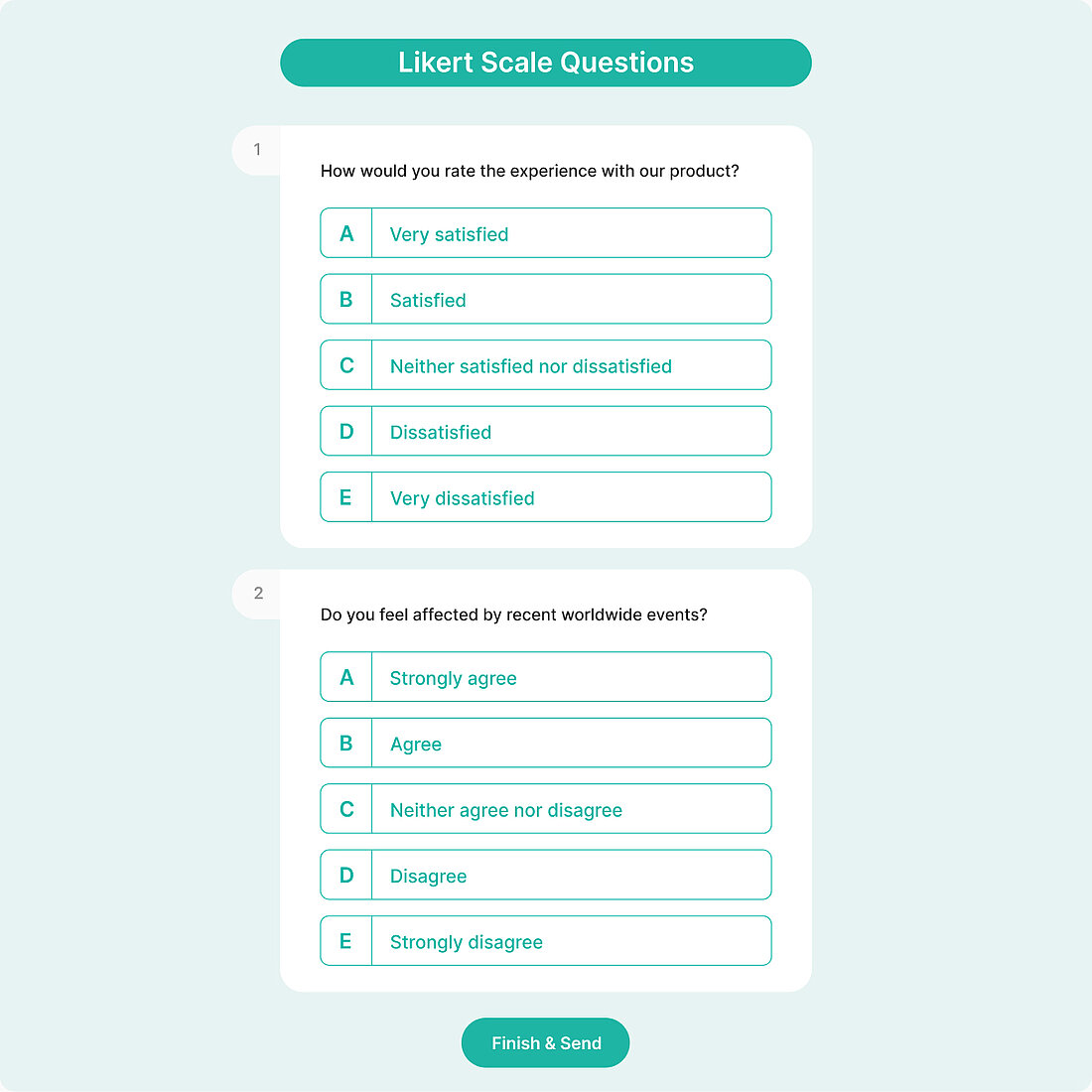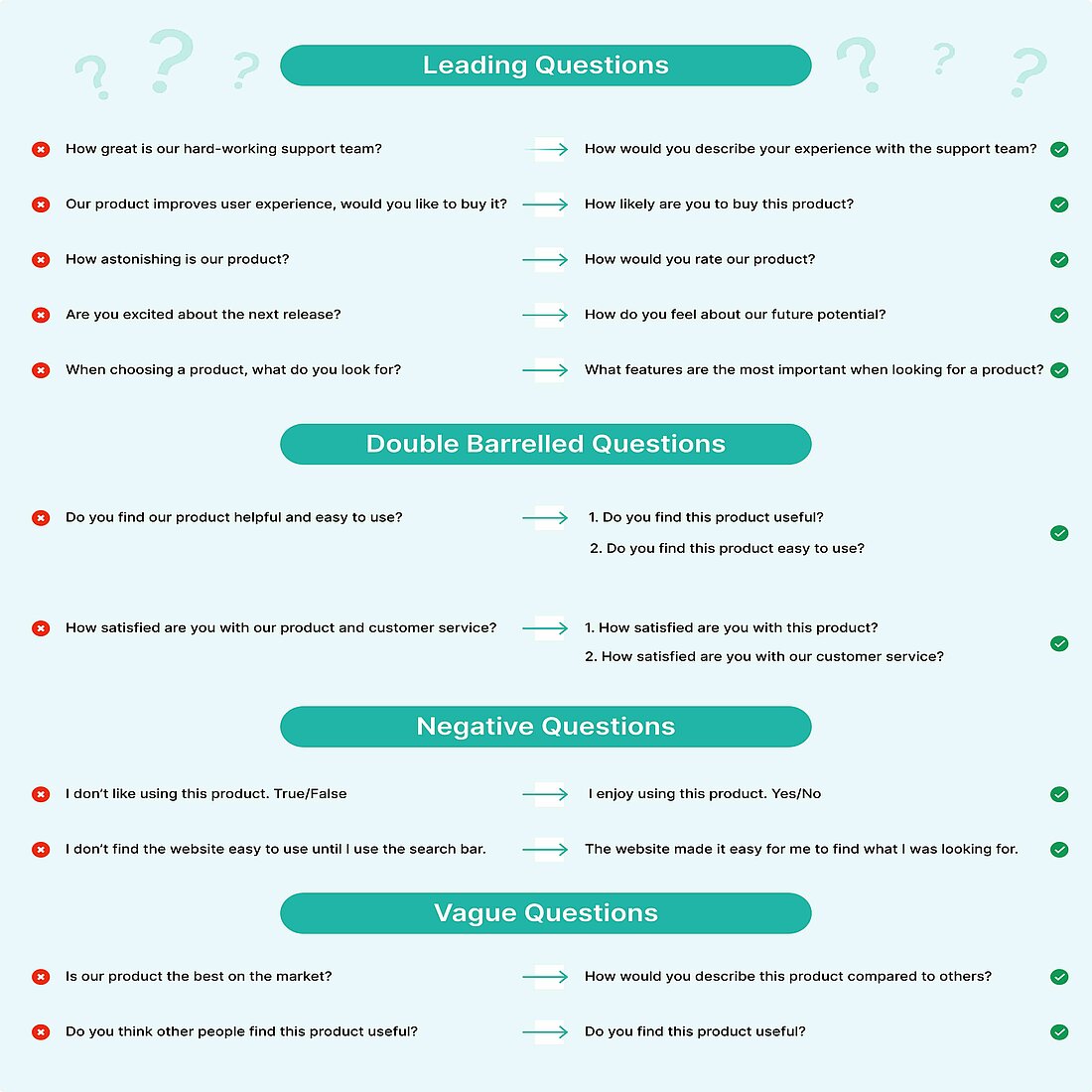- Why Us?
- Features
White Label
For SaaS Platforms & Agencies
Provide our complete analytics suite to your clients, directly within your own interface and with your/their own branding. Discover Analytics-as-a-Service and White Label Analytics. Great benefit, minimal effort.
- Pricing
- White Label
- Success Stories
- Partner
- ResourcesExpand Your Knowledge
CONTENTS
- What are Survey Questions?
- What are Common Survey Questions?
- What are the Six Types of Survey Questions
- Open-Ended Questions
- Closed-Ended Questions
- “Yes” or “No” Questions
- Nominal/Multiple Choice Questions
- Rating Scale Questions
- Likert Scale Questions
- What is a Powerful Question?
- What is a Good Survey Question?
- Why is it Important to Ask Good Survey Questions?
- 1. Identify Pain Points
- 2. Improve Customer Service
- 3. Increase Recommendations
- 4. Lower Bounce Rate
- 5. Minimize Churn Rate
- How to Run your Surveys
- Online Surveys
- Offline Surveys
- 8 Basic Demographic Survey Questions
- 20+ Effective Customer Questions
- 30 Product Survey Questions
- Satisfaction survey questions
- Other product survey questions
- What's the Difference Between Survey Questions and Non-Survey Questions?
- What are Examples of Bad Survey Questions?
- TWIPLA Survey Module
- You’ve Surveyed the Surveys!
Survey Questions: Increase Response Rates

Survey questions are the salt and pepper of business growth and product quality, such is the flavor that they add to the insights available from other website analytics tools - even the English keep some on their kitchen table!
These tools are essential for collecting the direct customer feedback that you need to best improve products, website performance, customer satisfaction, support service, and so on. The real struggle many businesses face is how to create the right survey questions, so that you get the insights you need!
Having the right questions in your survey will help you increase the response rate and get more answers from your customers. As a result, you can track the needs and improvements that your customers suggest.
Luckily, asking the right survey questions for your business goals isn’t rocket science, and this article will run through everything you need to know! Click on the link below to jump to the answer you need, or alternatively scroll through the article. See you at the bottom!
What are Survey Questions?
Survey questions are a type of research method in which you send questionnaires directly to customers. They are usually made up of different types of questions that come with a unique approach designed to gather specific information, and you can use these answers to improve your products or services.
Crucially, survey questions aren’t just for customers and clients! This tool can be used in house to get information from employees and colleagues, as well as for friends and family. They can be as fun or formal as you like, and about any subject you can think of.
DID YOU KNOW that only 1 in 26 customers will tell you about their bad experiences? With this in mind, running a survey is the best way to find out more about customers' issues and improve your product quality to ensure that they’ll continue using your product.

What are Common Survey Questions?
In business, the most frequently asked survey questions are about whether customers are satisfied with what they’ve bought, and their experience with your company as a whole. Go deeper however, and there is a wide range of questions that you can ask your customers:
What are the Six Types of Survey Questions
There’s no way around the reality that the wording of your survey questions will dictate how successful they are. There are generally six types of survey questions available, which overlap a little, so let’s dig a little deeper into what these are:
Open-Ended Questions
Open-ended survey questions don’t come with predetermined answer options, and ask respondents to write detailed responses to general questions. This question type enables you to gather qualitative information about a specific topic or problem, and gives customers the chance to elaborate in their responses as they wish.
Open-ended questions begin with “why”, “how”, and “what”, or with phrases like, “tell me about”, or “what do you think about”. Let’s look at a few examples of open-ended questions, so that we’re on the same page:
While open-ended questions seem at first glance to be the best option out there, it’s important not to use them. Since customers can respond to them in whatever way they want, the data you collect won’t be standardized, and this makes it difficult to pull specific insights from them.
What’s more, they do take a lot of time and effort from the respondent to fill in, and many customers leave blank spaces as a result. It’s also harder for you to pull out the information you need, and to analyze it effectively.
Closed-Ended Questions
Closed-ended questions are the opposite of open-ended questions, since respondents are given a limited number of options to choose from. They’re often yes/no questions, nominal (or multiple choice) questions that ask for gender, nationality, and so forth, and Linkert or other rating scale questions. Let’s look at a few examples of closed-ended questions:
This question type is really useful for collecting quantifiable data, since the pre-set answers are ideal for collecting specific insights from large numbers of respondents. Respondents also prefer them because they can be answered in the blink of an eye, and this increases the response rate too!
However, they work best when used in combination with open-ended questions. It’s good practice to start a survey with some closed-ended questions to get the respondents used to it, before they move on to open-ended questions that will take more time to complete. But by starting with closed-ended ones - respondents are much less likely to leave the form unfilled - that’s science!
“Yes” or “No” Questions
Yes-no questions - otherwise known as polar questions or general questions - are questions that can only be answered by either affirming the question, or with a negative answer. Everyone likes straightforward questions - they’re easy to answer and don’t require much effort. Just for clarity, let’s run through a few examples of “yes”/”no” survey questions:
In many ways, yes/no questions are the best type of survey question out there because you can get accurate, specific data about a subject. Crucially, you can use them to design a survey that only collects data on respondents who have answered the leading question in the same way - enabling you to easily segment responses and create an actionable analytics report.
Nominal/Multiple Choice Questions
Nominal survey questions require users to choose one or more options from a set of multiple choices, with some good examples listed below:
As you can see, nominal questions are quick and easy to answer, and are a great method for collecting specific data that can’t be limited to a binary choice.
However, they have a downsize! You’ll often find that with certain subjects - take nationality for instance, and the 223 that exist today - there are just too many answers to include in a multiple choice format.
Ultimately, you’ll want to limit the number of answers to nominal questions to four or five options, but there’s a trick with questions that have more multiple choice answers than this. All you have to do is integrate an open-ended question - namely “other”, as an answer option so that respondents have a way to answer the question accurately.
Rating Scale Questions
As you probably already know, a rating scale survey question comes with a well-defined range and requires respondents to choose an option from 0 to 5, to 0 to 10, or whatever range you prefer. Let’s have a look at two examples:
Rating scale questions are really useful for comparing historical data and identifying whether your business is improving or not.
Let’s say you had a rating scale question like “How satisfied are you with our product on a scale of 0 to 10?” last year. Now, you can add the same question to the survey and see if the rating scale is higher or lower. This kind of question really helps you to measure if your business is getting better or worse.

Likert Scale Questions
Likert scale - or ordinal - questions can be answered using a five or seven-point scale, and the two examples below should give you a good idea of exactly what they are:
Likert scale survey questions are the perfect type if you want to quantify the perceptions or opinions of your audience. The answers are always structured in the same way, and cover the general spectrum of feelings that the respondents have to your question.
These types of survey questions are also useful if you already have little information about the challenges that respondents faced. Using them, you only need to measure the intensity of the issue by asking them to choose the satisfaction level.
What is a Powerful Question?
A powerful question is an open-ended question that allows respondents to answer in detail, and gets its name from its potential to provide you with issues that you hadn’t previously considered, as well as a deeper understanding of things you already knew about.
A powerful question gives respondents the chance to elaborate at depth in their answers, and provides real scope of data to your process of analyzing data and improving performance.
What is a Good Survey Question?
If we think logically, a good survey question will help you get the precise information that you need from customers to optimize whatever work you’re doing. As such, it’s best to establish your survey goals before writing the necessary questions.
When the respondents are motivated and the survey is well-designed, response rates can reach over 85% (about 43 responses for every 50 invitations received). By achieving all of these and integrating the results into your product or website, you’ll find that your conversion rates will skyrocket.
Why is it Important to Ask Good Survey Questions?
Asking the right questions will give you more insight into what’s going well and what’s not, and will enable you to optimize whatever part of the business you’re focusing on. Let’s look at the five key benefits to good survey questions:
1. Identify Pain Points
Good survey questions enable you to find out what your customers like about your product or service, and where you can make improvements. Asking the right questions will also help you identify their pain points about your company in a way that stops them feeling confused and abandoning your survey.
2. Improve Customer Service
Ask the right survey questions and you’ll see your customer satisfaction soar! This is because the insights will enable your company to allocate resources to the areas where they are most needed, and improve business performance in areas that your customers really care about.
3. Increase Recommendations
Surveys are a great tool for improving the quality of your products and the all-important user experience, as well as for building relationships with your customers. Taken together, these will all have a knock-on effect on your company’s reputation, and how likely people are to recommend your business to people around them.
4. Lower Bounce Rate
Your bounce rate is a measurement of the proportion of visitors who leave your website immediately because they did not find something relevant. This is a key digital business metric, and a strong indicator that visitors are not happy with your website.
Survey questions are a great way to find out what they like and don’t like about your website, and what’s stopping them from converting - with real advantages to the overall user experience.
This is particularly true since a good website analytics tool like our own TWIPLA platform enables you to integrate surveys directly into the webpages that you want to analyze.
5. Minimize Churn Rate
Your churn rate is a measurement of the percentage of customers who stop doing business with you during a predefined period of time. If your churn rate is high, it's a powerful indicator that something is going wrong. Survey questions enable you to pinpoint exactly what this is, and you can then use these insights to make data-driven improvements accordingly.
How to Run your Surveys

You’ll want to action your surveys differently depending on your business type and immediate objective, but all companies can choose to conduct them either online, or out in the real world, and we’ll now run through some advice for each of these two avenues:
Online Surveys
You can take advantage of various templates and tools intended to help you design and customize the survey questions, with a wide range of channels to choose from. These include:
- Social media - Nowadays, people use social media very often. Running a survey on social media will help you get in touch with your customers and gather responses on various social media platforms: LinkedIn, Twitter, Facebook, and so on.
- Email - If you already have a customer email list, the easiest way to collect answers is to send your survey via email. Sending an email to customers also makes the process feel more personal than adding a link to your wall/website.
- PopUps - You can also use website popups on specific pages. With a popup survey on your website, you can gather real-time feedback on specific information such as the performance of your landing page, pricing page, store etc.
- Website - Another option for sharing the survey questions is to add a visible link to your website. This method can be effective for people who want to leave comprehensive feedback whenever they are satisfied or dissatisfied with your product/service.
Offline Surveys
Back before the internet took over, surveys were traditionally given to respondents in physical form, and they’d need to fill them in in person. This may now appear positively medieval, but this additional real-world pressure meant that respondents were more likely to complete them, and would often write more information than what they do online.
Offline surveys are still useful, particularly since they provide you with an opportunity to speak directly to customers, and make them feel valued. They’re also a pretty novel marketing and sales approach, given that people are so detached from the companies they buy from in the modern world.
Offline surveys can be run exactly as you imagine - you can mail surveys to your customers, give them to people in the street, or leave them in public spaces for them to answer. Alternatively, you could take advantage of the kiosk survey platform
8 Basic Demographic Survey Questions

Demographic survey questions enable you to understand who your customers are, with some common examples being:
- How old are you?
- What’s your gender?
- Where do you live?
- What is your level of education?
- Where do you work?
- What is your profession?
- How would you describe your employment status?
- How many employees work at your company?
Demographic questions are a great way to start surveys, because this information will enable you to segment respondents in a way that makes any insights gleaned useful. However, it’s important to remember that these questions are boring to answer repetitively. Include too many in every survey however, and they’ll put people off.
20+ Effective Customer Questions
Now that you have a basic understanding of what you want to get from your survey, you’ll want to think about the survey questions you include. Now we’re no mind readers, so we’ve collected 20 common customer questions that you can use to guide your thinking:
- What was your first impression of the product or service?
- How likely are you to replace an old product with a new one?
- What did you like most about our product?
- What stopped you from buying our product?
- What do we need to improve to make your buying decision easier?
- What can we improve about the checkout process?
- What convinced you to buy our product?
- Is there anything that almost stopped you from purchasing the product?
- What will you miss the most if we take our product off the market?
- Did you find the information you were looking for?
- How satisfied are you with our product?
- Will you recommend the product to your friends and family?
- How do you feel about the product’s price?
- How likely are you to buy from our company again?
- What made you buy from us rather than our competitors?
- What products would you like us to provide?
- When was the last time you purchased such a product?
- Are your purchasing decisions influenced by social media?
- What features would you like to see improved?
- Are you satisfied with the customer service provided?
- How helpful was the support team?
- How can we improve the customer service experience?
- What did you like best about the support team?
- Did the support team help you solve the problem as you expected?
30 Product Survey Questions
If you want to create a survey because you want customer feedback about your products, then you’ll need to decide whether you want to know about their satisfaction, or something else. Here’s some product survey question examples to help your brainstorming session:
Satisfaction survey questions
- How satisfied are you with our product on a scale of 1 to 10?
- Did our product meet your expectations?
- Is there anything we can improve on our product?
- What do you like most about our product?
- What do you dislike about our product?
- How well did our team understand your needs?
- Did you think our team is knowledgeable?
- Did you feel comfortable using our product?
- Would you choose us again?
- How would you rate our product on a scale of 1 to 10?
Other product survey questions
- How often do you use our product?
- Have you tried other similar products before?
- How easy is it to use our product?
- What made you choose our product over others?
- What features do you use most?
- What features do you think we should integrate into our product?
- If we didn’t create this product, what alternatives would you choose? Why?
- Do you consider our product worth the money?
- What issues do you solve using this product?
- Did you find what you were looking for on our website?
- How easy was it to find our product on the website?
- Where did you hear about this product?
- How satisfied are you with our return policy?
- How easy was it to finish the purchase?
- Did you receive your order in a timely manner?
- Did you like our packaging?
- If we remove the product from the market, what would you miss the most?
- Are you concerned about sharing credit card information with us?
- How likely are you to recommend this product to your friends and family?
- What problem would you like to bring to our attention?

What's the Difference Between Survey Questions and Non-Survey Questions?
Survey and non-survey questions have different purposes. Survey questions are used to collect data about the performance of your product, website, customer service, and so on, while non-survey questions are important for building an email list, owning delivery information, accepting payment, and whatever you need.
Another important difference is that a survey includes both data collection and analysis while a questionnaire (non-survey) only involves the process of collecting information about customers.
What are Examples of Bad Survey Questions?
Ultimately, most bad survey questions use words that influence or confuse the answers of users in some way. This could be anything from being too vague and including too much information, to writing double negatives or even typos.
Let’s have a look at some examples of bad survey questions, and how to improve them:
TWIPLA Survey Module
Surveys have stood the test of time, and remain one of the best ways to get direct feedback from your audience. However, it can be hard to find a survey tool that will enable you to analyze the data itself - one of the most time-consuming aspects of this marketing work.
But don’t worry - we’ve got you covered! Our TWIPLA Survey Module will walk you through a simple and fully customizable survey creation process, before automatically analyzing the collected data. Survey says…. it’s a pretty useful tool, and the reviews are none too shabby either!
Our survey tool speeds up the creation of good surveys, by enabling you to choose from a predefined list of question categories such as long/short text questions, multiple choice, scale, rating, email address, website link, and so on.
Crucially, you can also divide the questions into pages so that the sheer number of questions isn't enough by itself to put customers off from answering it. You can also save your questions, and reuse them in other surveys and polls.
What’s more, you can automatically segment your surveys even before sending them out, by setting access rules on anything from geographic location to customer type. This little trick is a great way to increase the usefulness of any data you collect, and the speed of analysis that comes afterwards.
And here’s the icing on the cake; since this tool is part of our wider website analytics platform, you can use the survey feature alongside other website performance statistics and visitor behavioral tools to create a high resolution image of what’s happening on your website, and how to improve it effectively.
You’ve Surveyed the Surveys!
We hope that you now have a better understanding of the work that goes into creating good survey questions, and why they’re such an effective marketing tool!
If you found this article useful, don’t hesitate to share it with your family, friends, or colleagues. We all love good articles that offer us helpful information!
Share article
Get Started for Free
Gain World-Class Insights & Offer Innovative Privacy & Security

You might also like
42 Essential KPIs for eCommerce Websites 07 February 2021 - by Simon Coulthard
07 February 2021 - by Simon Coulthard
Top 12 Session Replay Tools to Improve User Experience 16 October 2020 - by Simon Coulthard
16 October 2020 - by Simon Coulthard
Google Analytics 4 Drawbacks. Why Should You Not Upgrade to GA4 29 August 2022 - by Simon Coulthard
29 August 2022 - by Simon Coulthard











